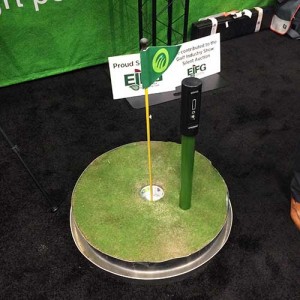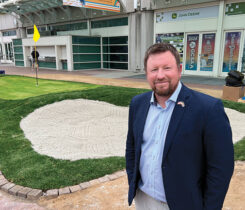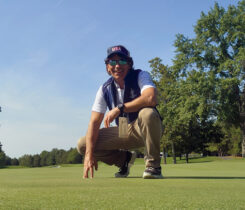A different Pogo stick

Pogo is stuck in the ground to measure what going on in the soil, and allows superintendents to see visual reports on thing such as moisture and salinity.
While walking past the Pogo booth on the GIS trade show floor, you’d be forgiven for thinking the product is a pogo stick. You’d be wrong, but you’d also be right.
Pogo, now about a year and a half in the market, looks a bit like a pogo stick, but that’s where the resemblance ends.
Pogo, which is stuck in the turf, is really “an integrated system for providing knowledge and insight about the health of one’s turf,” according to Pogo Director of Marketing Eric Embacher, who says Pogo “allows you to know what your turf needs so you can take the right action to make the best decisions possible to keep it as healthy as possible.”
“The Pogo stick is the data-gathering too,” he notes. “It’s not a moisture sensor, but it does measure moisture, but it also measures salinity, so it’s a much more complete tool. It also measures canopy temperature, and it’s also got an integrated GPS, a very industrial-quality GPS – we call it sub meter – that allows you to pinpoint exactly where you’re taking every reading.”
The other aspect of the system, Embacher notes, is an app. The app allows interaction with the device in order to take samples. “From there, the data that’s stored in the app can get forwarded to the cloud, and the cloud system is what does the heavy lifting, the big analysis of the data that you’re gathering. It starts crunching through all the numbers, allowing you to display the information visually, so it’s not providing tables of boring numbers.” The generated reports, Embacher says, could be trend, distribution and uniformity reports.
Superintendents need to know what’s going on in the soil, he says. “There’s much more to the story than just moisture. It’s really the interaction between moisture and salinity that tells you the whole story. If you’re just measuring moisture, you’re getting less than half of the picture.”
You poke Pogo in the ground (the name comes from “poke and go”), and “nine to 12 samples per green gives you fantastic coverage and results in very graphical, very insightful reports and shows you what you’re measuring in pictorial form, kind of like a heat map of your green, superimposed on satellite imagery.”
That’s a heck of a lot more than a pogo stick could do for your course.
Photos: Golfdom










